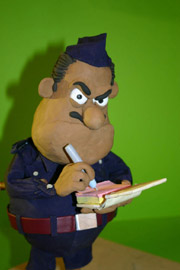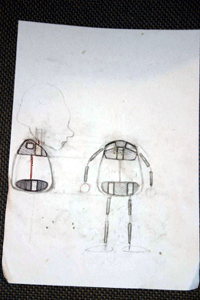 What do you say about a man who has breathed life into umpteen memorable animated characters in a country where the medium of animation is generally perceived as children’s entertainment? Vaibhav Kumaresh, the man behind the unique animation seen in the Amaron ads and the characters Poga (MTV) and Simpoo (Channel V), is indeed an animator par excellence.
What do you say about a man who has breathed life into umpteen memorable animated characters in a country where the medium of animation is generally perceived as children’s entertainment? Vaibhav Kumaresh, the man behind the unique animation seen in the Amaron ads and the characters Poga (MTV) and Simpoo (Channel V), is indeed an animator par excellence.
Vaibhav’s unique style of using clay animation to create lovable characters in action-packed settings has won him thousands of ardent fans. A number of young student animators idolise him, and when TASI (The Animation Society of India) hosted an interactive session conducted by Kumaresh, it was but natural that the audience would see a lot of young faces.
That said, the turnout for this session surpassed all expectations. More than half of the ensemble that had gathered at Ramnarain Ruia College, Matunga, comprised of students. The session was held so that Kumaresh could share his experience of working on a clay animation film ‘Horn OK Please’, in Ireland. The film, which is currently under production, has been co-produced by Belfast-based Flicker Pics Ltd, the British Council and the Irish Film Board.
It all began, Kumaresh told the audience, when Joel Simon, the director of Flicker Pics Ltd, visited India a couple of years ago. Eager to know about the animation scenario in India, he met a number of leading animators, including Kireet Khurana, who referred him to Vaibhav Kumaresh, as being one of the leading exponents of stop motion animation. Although they didn’t meet owing to Kumaresh not being in town that time, they began corresponding via e-mail, and when Simon decided to make an animation film on the life of a Mumbai taxi driver, Kumaresh was the first person who came to his mind.
‘Horn OK Please’ is a film that was conceptualised in order to depict a typical day in the life of a Mumbai cabbie – the monotony, the entire rut of being at the wheel all day, which is sprinkled with a sense of variety every time a new passenger boards the taxi.
The film was scripted before Kumaresh left for Ireland, but a number of changes were made by Kumaresh himself. Certain clich?©s were done away with, and he made suggestions in order to make the film more believable.
The story is how the taxi-driver dreams about buying a luxurious car, for which, he keeps collecting money. There is a concept of money-meter which goes up as the cabbie keeps getting more and more passengers. The individual quirks and the mannerisms of the different passengers form an important part of the film’s narrative.

While Kumaresh was given a lot of creative freedom, the final decision always lay with Joel Simon. This merger meant the meeting of two vastly contrasting styles of film-making. While Vaiabhav Kumaresh’s style has always been racy and action-packed, with him having a penchant for hyperbole, Joel Simon, on the other hand, has a style that usually does not involve a lot of moving characters. Along with conventional displacement techniques used in clay animation, Flicker Pics Ltd also uses the replacement technique, wherein there are numerous models having different expressions – for example, ten different pairs of eyes, each having a different expression, which are stuck onto the main model as and when required. This is particularly useful when the film is one where there isn’t too much action – like a chat show, for example. It also makes working with miniature models easier.
In making ‘Horn OK Please’, the two have attempted to blend each other’s styles – taking the best of both worlds, so to say.
Kumaresh shared with the audience all the rough sketches which were made while deciding the look of the principal characters. He also showed all the stills of the animatics of the entire film, including those that aren’t going to be included in the final product.
The two main characters of the film are Lucky, the taxi-driver, and Arun, a young kid. While all characters were made using clay, the two main characters had armatures made using ball-and-socket joints. Special KNS brass tubes were used for these two characters in order to support the aluminum wires that were used. Other materials used included thermocol and different types of adhesive.
While making the two main characters, Kumaresh had to keep in mind the way each one displays his emotions. He has always used the eyebrows of any particular character to display his emotions, while what he found at Flicker Pics was that most of the characters created by them do not even have eyebrows! Consequently, the character of Arun was created sans any eyebrows. The taxi-driver has been depicted as an indolent, laid-back character who is so sluggish that he merely shrugs his shoulders even when in the worst of situations. He has been given a moustache which reflects his mood and the emotions he goes through, much like Shikari Shambu.
Other characters include the passengers that board Lucky’s taxi – a jogger, a couple who try to get cozy in the taxi, a Bollywood starlet and her secretary, an old, irritable lady and a nervous tourist. There are also traffic cops and eunuchs, among other characters that one encounters on the road.
A significant feature of ‘Horn OK Please’ is the use of morph shots, which are Kumaresh’s forte. Similar to the ones he used while creating Poga on MTV, the morph shots have the old, irritable passenger converting into a turkey, and the traffic cop becoming a demon. All these morph shots are part of the driver’s hallucinations when the day’s grind becomes too much for him to bear.
The only problem they faced, according to Kumaresh, was the depiction of the visualization outside the taxi – the background that needs to move in a way that the viewer will get the impression that the taxi is moving ahead. It was not easy, as a variety of methods were tried and discarded, without any significant progress. Initially, the plan was to use background shots in hand-painted 2-D layers, but the motion of the camera rendered this useless as the background didn’t merge with the taxi properly. The final decision was to use computer graphics (CG), along with 2-D textures. This has resulted in the various pencil thatches and strokes used to make the 2-D textures being retained in the final result, but the CG used ensures that the physical world moves convincingly. Motion blur was then used to hide the conspicuous flaws.
Although a section of the audience thought that even after these efforts, the use of backgrounds made the film resemble an old movie, where the background is a trifle disconnected from the subject, everyone was unanimous in their verdict that even this seemingly flawed technicality does not take anything away from Kumaresh and the rest of the team at Flicker Pics Ltd, who have created characters that are lovable and produced a story that is funny and entertaining.
The film which is still under production, is currently having a few rough edges smoothened out. Vaibhav Kumaresh is not a physical part of the scene at the moment, as he is back in Mumbai after the three months that he spent in Belfast, but he continues to correspond with Joel Simon to work towards the final product.
Summing up the session, Kumaresh said that the opportunity to work in Ireland exposed him to a whole new world of animation, entirely different styles, and yet, he realised, that we in India, are very much on the right track. He signed off, hoping that such mergers continue in the future. We too, hope that more such interactive sessions with leading animators like Vaibhav Kumaresh continue to be held in the future.
